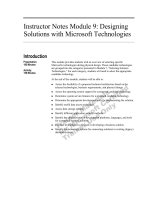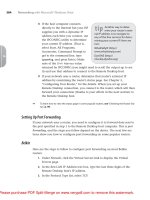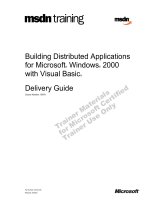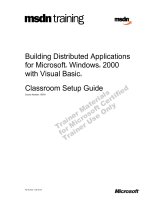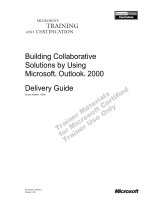Building ERP solutions with microsoft dynamics NAV
Bạn đang xem bản rút gọn của tài liệu. Xem và tải ngay bản đầy đủ của tài liệu tại đây (27.44 MB, 407 trang )
Contents
1: Introduction to Microsoft Dynamics NAV Architectures
b'Chapter 1: Introduction to Microsoft Dynamics NAV Architectures
'
b'Introducing Microsoft Dynamics NAV'
b'Microsoft Dynamics NAV history'
b'Microsoft Dynamics NAV architecture'
b'Microsoft Dynamics NAV deployments'
b'Differences between NAV deployments'
b'Performance and installation tips'
b'Summary'
2: Configuring Microsoft Dynamics NAV Web Services
b'Chapter 2: Configuring Microsoft Dynamics NAV Web Services'
b'Microsoft Dynamics NAV web service protocols'
b'Microsoft Dynamics NAV web service types'
b'Publishing NAV web services'
b'Summary'
3: Creating an Application Using NAV Web Services
b'Chapter 3: Creating an Application Using NAV Web Services'
b'Creating the NAV web service'
b'Creating the consumer application'
b'Testing the application'
b'Using an OData web service'
b'Extending the application for deleting NAV sales order lines'
b'Creating a cross-platform application'
b'Tips and tricks'
b'Summary'
4: Using NAV Web Services with Microsoft Power BI
b'Chapter 4: Using NAV Web Services with Microsoft Power BI'
b'Introducing Microsoft Power BI'
b'Publishing NAV data for Power BI'
b'Loading NAV data on the Power BI desktop'
b'Publishing your NAV dashboard to the Power BI portal'
b'Microsoft Dynamics NAV content pack for Power BI'
b'Summary'
5: Integrating NAV Web Services and External Applications
b'Chapter 5: Integrating NAV Web Services and External
Applications'
b'An overview of the business scenario'
b'Creating NAV business logic'
b'Publishing the NAV objects'
b'Creating the service layer'
b'Testing the solution'
b'Solution deployment'
b'Summary'
6: Extending NAV Pages with Control Add-ins
b'Chapter 6: Extending NAV Pages with Control Add-ins'
b'A business case'
b'Control add-in implementation'
b'Universal control add-in'
b'Control add-in deployment'
b'Summary'
7: Programming Universal Windows Apps with NAV and Devices
b'Chapter 7: Programming Universal Windows Apps with NAV and
Devices'
b'Business case 1 - handling mobile informations with NAV\xc2\xa0'
b'Business case 2 - NAV and the Microsoft Band for healthcare'
b'Business case 2 - developing the Band 2 application'
b'Summary'
8: Exploring Microsoft Azure and its Services
b'Chapter 8: Exploring Microsoft Azure and its Services'
b'The Microsoft Azure platform'
b'Azure Virtual Machines'
b'Azure App Service'
b'Azure Cloud Services'
b'Azure Batch Services'
b'Azure Scheduler'
b'Azure Virtual Network'
b'Azure Active Directory'
b'Azure Storage'
b'Azure Logic Apps'
b'Azure SQL Database'
b'Azure SQL Data Warehouse'
b'Azure Analysis Services'
b'Azure Service Bus'
b'Azure Machine Learning'
b'Azure Internet of Things (IoT) suite'
b'Summary'
9: Working with NAV and Azure App Service
b'Chapter 9: Working with NAV and Azure App Service'
b'The business scenario'
b'Azure App Service\xc2\xa0'
b'Developing the solution'
b'Deployment to Azure App Service'
b'Summary'
10: Implementing a Message-Based Architecture with Azure Service Bus
and NAV
b'Chapter 10: Implementing a Message-Based Architecture with
Azure Service Bus and NAV'
b'The business scenario'
b'An overview of the Azure Service Bus\xc2\xa0'
b'Developing the solution'
b'Testing the application'
b'Summary'
Chapter 1. Introduction to Microsoft
Dynamics NAV Architectures
Microsoft Dynamics NAV is an Enterprise resource planning (ERP)
software and it is part of the Microsoft Dynamics product's family.
In this chapter, we will cover the following topics:
Microsoft Dynamics NAV and its functional areas
History of Microsoft Dynamics NAV
An overview of Microsoft Dynamics NAV architectures and components
NAV deployment's solutions and the differences between them
Introducing Microsoft Dynamics NAV
Microsoft Dynamics NAV delivers integrated functionality to provide support
for the following aspects:
Financial management
Supply chain management
Manufacturing
Distribution
Customer relationship management
Sales and marketing
Service management
Human resource management
Project and resource management
Warehouse management
Microsoft Dynamics NAV is considered to be one of the most versatile and
agile ERPs on the market. It's very quick and affordable to customize and it has
the power to be able to grow with your business needs.
With NAV you can customize every aspect of the application (from fields to
business logic) and you can build new modules from scratch. You have
complete access to the source code of the application and you have an
integrated environment that helps you to make customizations and
implementations.
Microsoft Dynamics NAV history
Microsoft Dynamics NAV was born from Navision, a suite of accounting
applications which Microsoft acquired in 2002.
Navision was created at Personal Computing and Consulting (PC&C A/S),
a company founded in Denmark in 1983 by three college students. This
company released its first accounting package, PC Plus, in 1984 (a single-user
character-based application) and then in 1987 they released the first version of
Navision, a character-based client/server accounting application that works
over a LAN and with more simultaneous users:
In 1990, Navision 3.0 was launched. This version introduced AL, an internal
application language similar to the actual Client/server Application
Language (C/AL). This was a killer feature: the new application language
made it possible to customize every part of the application and this was unique
on the market at that time.
The product grew and in 1995 Navision Financials 1.0 was launched based on
the Microsoft Windows 32-bit client/server platform:
The product was improved in the following years by adding more features as
follows:
Integration of e-commerce applications such as Commerce Gateway,
Commerce Portal
User portal, browser-based access
Supply chain collaboration functionality including manufacturing and
distribution
Extended financial management functionality
Extended and new functionality within customer relationship management
Multicurrency
Multilanguage
On July 11, 2002, Navision was acquired by Microsoft and Microsoft created
the Microsoft Business Solutions division. In September, 2005 Microsoft rebranded the product as Microsoft Dynamics NAV.
In November 2008, Microsoft announced Microsoft Dynamics NAV 2009,
with a totally new architecture, as follows:
A new client called the RoleTailored Client
An old client (renamed as the Classic Client)
New objects called Pages for the RoleTailored Client
A new report architecture (RDLC with Visual Studio)
The possibility to have a three-tier architecture (with the RoleTailored
Client) and the old client/server architecture (with the Classic Client):
Microsoft Dynamics NAV has had continuous improvements over the years on
every aspect of its technical and functional side.
Microsoft Dynamics NAV 2013 introduced the following new features:
A totally new Web client with rich experience
A SharePoint client
Internal encoding is now Unicode (no longer ASCII)
The next main release, Microsoft Dynamics NAV 2013 R2, introduced the
following new features:
Multitenancy (optional): The multitenancy architecture in NAV 2013 R2
consists of a single application database (containing tables common to all
databases and objects) and multiple data databases (customer data and
login tables). One NAV service tier can serve one application database
and multiple tenant databases (and can also sit on different SQL server
instances).
Provisioning tools: These tools are used for fully automating the
deployment of NAV in Azure virtual machines (as IaaS). The provisioning
tools include a set of Windows PowerShell cmdlets and scripts that
install and configure Microsoft Dynamics NAV components, including
Microsoft Dynamics NAV web server components, Microsoft Dynamics
NAV Server, and SQL database components.
With Microsoft Dynamics NAV 2015, we saw the introduction of the
following topics:
RapidStart Services: This is a set of tools and services to automate and
speed up the setup and initialization phase of a NAV installation
New Tablet client: This is a new client for touch-optimized devices that
enables you to access your NAV data regardless of location or what
device you are using
Web client: The Web client is much improved and faster
Office 365 integration: This is simplified e-mail messaging via SMTP
including Office 365, signing in to the Windows client using an Office
365 account
Document reporting with Microsoft Word: With this release, Microsoft
has introduced the possibility to make document reporting by using Word
with NAV
With the next release, Microsoft Dynamics NAV 2016, Microsoft introduced
the following services:
NAV Universal App: By using the Universal Windows Platform, now we
have one single app for all devices (it works as a tablet application or as
a phone application according to the device you're using).
Eventing: Now we have events triggered on code like standard object
oriented programming. A publisher raises an event when something
happens and a subscriber can listen to this triggered event and make
actions.
Code editor: We have a new code editor with code completion and
IntelliSense.
Workflows: Based on eventing, you are now able to create your own
business workflows with conditions and responses.
Microsoft Dynamics NAV support in Power BI: When you enter your
Power BI account, now you have a new service called Microsoft
Dynamics NAV that permits you to integrate your data to Power BI.
Integration with CRM: Integration with CRM is now native (coded in
C/AL), so no more need to use the old CRM External Connector for
handling integration tasks.
Microsoft Dynamics NAV managed service for partners: A significant
new option for Microsoft partners interested in providing multitenant
Software as a Service (SaaS) solutions built on Microsoft Dynamics
NAV and deployed in the cloud on Microsoft Azure.
The latest release (Microsoft Dynamics NAV 2017) introduced the following
new features:
Assisted setup
Smart notifications
Cash flow forecast with Cortana Intelligence
Design mode in the Web client
Improved integration with Office 365 and a new Outlook add-in
Embedded Power BI reports in the NAV RoleTailored Client
Improved extensions (new ways to develope customizations)
Dynamics 365 for Financials (NAV as SaaS)
Now we have a complete and full-featured enterprise platform that is
appreciated all over the world, able to work on-premise and on-cloud, and on
many devices as shown in the following screenshot:
Microsoft Dynamics NAV architecture
Before version 2009, Microsoft Dynamics NAV had a two-tier architecture.
In two-tier architectures (client/server data model), the data layers reside on
the server and the application logic, presentation logic, and presentation layers
reside on the client.
Starting from version 2009, Microsoft Dynamics NAV is composed of three
major components (three-tier architecture), as follows:
Data tier: A database (database server) where the data are stored.
Actually Microsoft Dynamics NAV supports only Microsoft SQL Server
as the database server.
Middle or service tier: This is an application server. A NAV service that
controls all the NAV business logic and operations.
Client tier: This represents NAV clients and is the layer that handles the
real user interface for the application (presentation logic). NAV can have
different types of client as follows:
Windows client
Web client
Tablet client
Phone client
In a production environment, you can obviously have multiple instances of
each of the core NAV components:
The most common NAV architecture configurations that you can have in a realworld installation are as follows:
All three tiers are on the same computer, useful only for a demo or a
developer dedicated environment.
The RoleTailored client and Microsoft Dynamics NAV Server are on the
same computer, the data tier is on a separate computer.
The data tier and Microsoft Dynamics NAV Server are on the same
computer. The RoleTailored client is on a separate computer (one of the
most common scenarios).
Each of the three tiers is on a separate computer. This is the suggested
configuration for a production environment.
In addition to these three core components, there are other additional
components that you can have on a NAV installation:
Component
Purpose
Microsoft
Dynamics
NAV Help
Server
A website with the Help content for Microsoft Dynamics NAV
in the languages that your version of Microsoft Dynamics NAV
includes. You can deploy a single Help Server for all users, or
customer-specific Help Servers, depending on your
requirements.
Web Server
Components
The components that are needed to enable Microsoft Dynamics
NAV Web clients to connect with a browser.
Microsoft
Dynamics
A tool for configuring and managing the Microsoft Dynamics
NAV Server NAV Server and Microsoft Dynamics NAV sites. It has a GUI
Administration that permits an easy way to manage all the server's features.
Tool
Development The Development Environment for creating and modifying
Environment Microsoft Dynamics NAV applications (business logic) in
(C/SIDE)
C/AL.
Microsoft
A set of components for synchronizing data, such as to-dos,
Office Outlook
contacts, and tasks, between Microsoft Dynamics NAV and
Add-In and
Outlook and using Dynamics NAV as your business Inbox in
Business
Outlook.
Inbox
A Microsoft Dynamics NAV tool for accurately capturing data
for inbound, outbound, and internal documents, primarily in
Automated
connection with warehouse activities. With Automated Data
Data Capture
Capture System (ADCS), company employees use handheld
System
devices and radio frequency technology to continuously
validate warehouse inventories.
ClickOnce
A set of tools designed to create ClickOnce deployments for
Installer Tools applications for the Microsoft Dynamics NAV Windows client.
When using the NAV Web client, all NAV web server components are installed
as a website on the Internet Information Server (IIS), so you need to install
and properly configure it:
You can deploy the web server components on one computer or on separate
computers (for example, Microsoft Dynamics NAV web server components
installed on a server and Microsoft Dynamics NAV Server and SQL Server
installed on another server). When you install Microsoft Dynamics NAV web
server components, the setup adds a web server instance (virtual directory and
application) on IIS for the Microsoft Dynamics NAV Web client.
Microsoft Dynamics NAV supports four methods for authenticating users who
access the Microsoft Dynamics NAV Web client: Windows, UserName,
NavUserPassword, and AccessControlService. Windows authentication is
configured by default.
When installing the Microsoft Dynamics NAV web server components (or after
installation), you can also enable Secure Sockets Layer (SSL) on the
connection to the Microsoft Dynamics NAV Web client to increase security.
The following table describes the required components when using the Web
client:
Tier
Description
Device
A computer or device that has access to the Internet with a
browser.
Web Server
A computer that is running IIS. Microsoft Dynamics NAV web
server components are installed on a website on IIS.
Microsoft
A Microsoft .NET Framework-based Windows service that
Dynamics NAV manages communications and provides a security layer
Server
between clients and Microsoft Dynamics NAV databases in
(Service Tier) SQL Server.
When activated, the NAV Web client appears as shown in the following
screenshot:
As previously described, starting from Microsoft Dynamics NAV 2016, we
have also native clients for mobile devices. Here is a quick view of the NAV
Phone client in the following screenshot:
You can now download a native Microsoft Dynamics NAV application from
the store of your mobile platform (iOS, Android, Windows):
After downloading the app from the store, you can start using Microsoft
Dynamics NAV from your mobile device. You can also work with your NAV
data directly from Outlook:
In Outlook, you can now also create new NAV documents:
The new three-tier architecture is multithreaded and it can handle more than
one process at a time. Actually, the Microsoft Dynamics NAV server can be
installed only on 64-bit operating systems and it requires a 64-bit Microsoft
SQL Server version.
Regarding the NAV client, the Windows client can be installed on 32-bit or 64bit operating systems.
If you install the NAV Windows client on a 64-bit OS, you will have two
version of the client installed (32-bit and 64-bit). The default is the 64-bit
Windows client, but obviously you can change it.
If you install the NAV Windows client on a 32-bit OS, you will have only the
32-bit client installed.
Microsoft Dynamics NAV also supports deployments where several different
companies access a centrally maintained Microsoft Dynamics NAV
application. This is called a multitenant architecture.
In a multitenant architecture, information about the Microsoft Dynamics NAV
application is stored in a separate application database while data is stored in
separate business databases, each of which is a tenant in your deployment.
By separating the application from the data, you can deploy the same solution
to many customers with centralized maintenance of the application and
isolation of each tenant.
The application database contains the tables that define an application and
other NAV system tables.
Microsoft Dynamics NAV now includes Windows PowerShell cmdlets that
create an application database, and other cmdlets that enable you to create and
administer tenant-specific databases. You can find a complete overview of
every cmdlets at />The Export-NAVApplication cmdlet is the one used to extract application
tables in a Microsoft Dynamics NAV database to a separate database. The new
application database is created on the same SQL Server instance as the
original database.
The following table describes which system tables are moved to the
application database when you run this cmdlet and which tables remain in the
business data database:
Application database
Business data database
Chart
Access Control
Client Add-in
Active Session
Client Add-in Resources Company
Debugger Breakpoint
Device
Debugger Watch
Document Service
Object
Integration Page
Object Metadata
Object Metadata Snapshot
Object Tracking
Object Translation
Permission
Page Data Personalization
Permission Set
Printer Selection
Profile
Record Link
Profile Metadata
Report List Translation
Send-To Program
Session Event
Server Instance
User
Style Sheet
User Default Style Sheet
Web Service
User Metadata
User Personalization
User Property
Note
For more information and details about NAV installation, you can
check the Installation and Configuration Walkthroughs section at
/>
us/library/dd301193(v=nav.90).aspx.
Microsoft Dynamics NAV deployments
A NAV deployment can essentially be as follows:
On-premise
On-cloud (IaaS or PaaS)
SaaS
With an on-premise deployment, Microsoft Dynamics ERP software is hosted
at your own location on your own servers.
This type of architecture guarantees predictable performance (not subject to
Internet connection related fluctuations in performance or availability), you can
use the hardware and software infrastructure you already own, you can easily
connect NAV with external systems that you can have inside your company, and
obviously you have to guarantee data security (backup and so on) by yourself.
With on-cloud deployment, you can choose to deploy your NAV installation on
the cloud by choosing from an Infrastructure as a Service (IaaS) architecture
or a PaaS architecture. The Windows Azure platform permits you to have a
complete NAV environment (virtual machine) totally scalable. Security is
guaranteed by the Azure platform (redundancy, scalability, and so on).
Azure is the fastest and recommended way to implement a totally on-cloud
NAV deployment.
The on-cloud deployment permits you to minimize your initial IT investments
(no hardware costs, no IT staff for maintenance) and it supports your business
as it grows (costs can scale with the actual use and needs of your solutions).
In an on-cloud deployment, you can choose to have the Microsoft SQL Server
installed on a dedicated instance on an Azure virtual machine or you can use
the Azure SQL database, a cloud service that permits you to have the SQL



